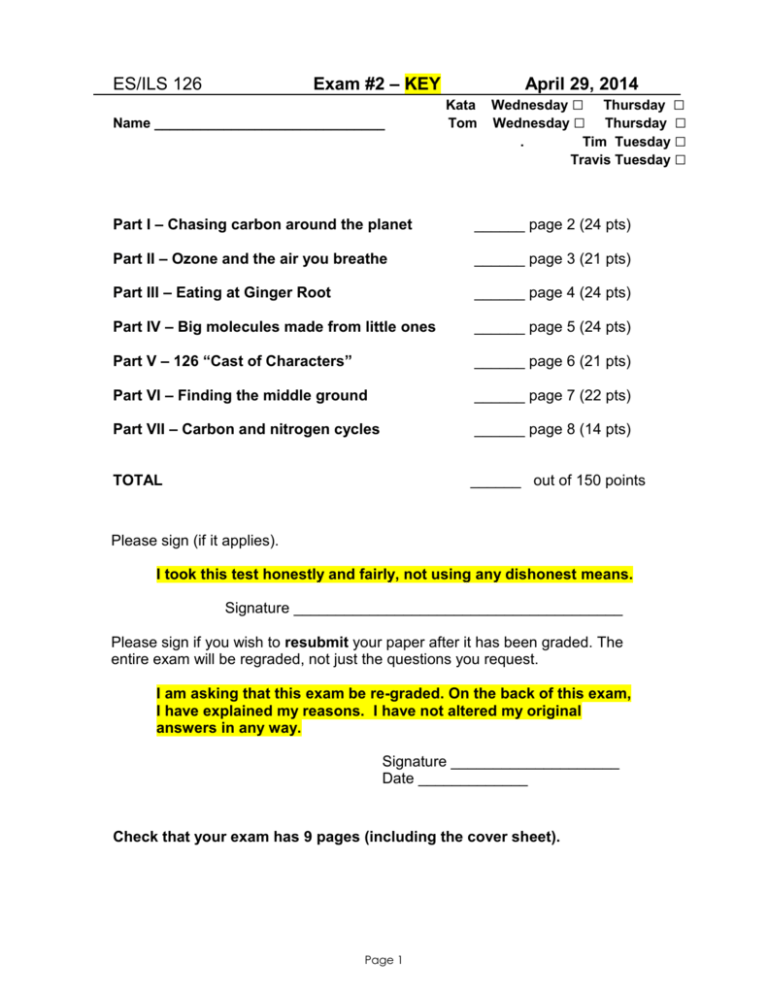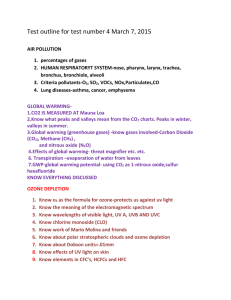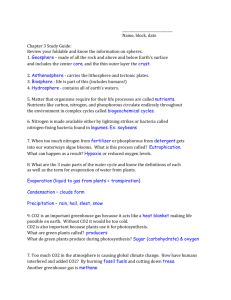Exam #2 KEY - Faculty and Research Staff
advertisement

Exam #2 – KEY ES/ILS 126 Name ______________________________ April 29, 2014 Kata Tom Wednesday □ Thursday □ Wednesday □ Thursday □ . Tim Tuesday □ Travis Tuesday □ Part I – Chasing carbon around the planet ______ page 2 (24 pts) Part II – Ozone and the air you breathe ______ page 3 (21 pts) Part III – Eating at Ginger Root ______ page 4 (24 pts) Part IV – Big molecules made from little ones ______ page 5 (24 pts) Part V – 126 “Cast of Characters” ______ page 6 (21 pts) Part VI – Finding the middle ground ______ page 7 (22 pts) Part VII – Carbon and nitrogen cycles ______ page 8 (14 pts) TOTAL ______ out of 150 points Please sign (if it applies). I took this test honestly and fairly, not using any dishonest means. Signature _______________________________________ Please sign if you wish to resubmit your paper after it has been graded. The entire exam will be regraded, not just the questions you request. I am asking that this exam be re-graded. On the back of this exam, I have explained my reasons. I have not altered my original answers in any way. Signature ____________________ Date _____________ Check that your exam has 9 pages (including the cover sheet). Page 1 Part I – Chasing carbon around the planet 1. THE message about carbon is written to the right. a. (3 points) Name three places that carbon is found on Earth. Possibilities include: animals, plants ocean, atmosphere rocks, soils b. (6 points) Name four processes that move carbon from one place to another. The first is done for you. 1. Photosynthesis Possibilities include: 2. Combustion 3. Respiraton 4. Decomposition, anaerobic or aerobic 5. Dissolving (and undissolving) into the ocean 6. Weathering of rocks c. (3 points ) Complete this sentence: It matters when carbon ends up in _________ because: (name a place) Possibilities include: The air … because CO2 is a greenhouse gas. The ocean … because dissolved CO2 affects coral and other sea creatures. Page 2 Part I – Chasing carbon around the planet (CONTINUED) 2. (12 points) Here is a graph produced by one of NOAA’s research labs. a. Give the graph a title. The change in atmospheric CO2 levels (or concentrations) over time. Note: these are NOT ocean levels of CO2! This graph came from the Week #8 lab activity b. Label the axes of the graph: x-axis (horizontal): _time (in years) y-axis (vertical): _Concentration of CO2 (in ppm) c. Explain the red “sawtooth” on the graph. The sawtooth is a result of the change of seasons. In spring, the CO2 levels drop when photosynthesis starts up again in green plants. In fall, the CO2 levels increase when green plants shut down for the winter. (Not necessary: Because there is much more land mass in the northern hemisphere, this hemisphere dominates the CO2 levels in the atmosphere) Page 3 Part II – Ozone and the air you breathe 1. Here are four chemical equations: a. (9 points) One of these reactions requires sunlight. Give its number: _#3__ One of these requires several hours, delaying the formation of ozone in the atmosphere. Give its number: __#2_____ One of these reactions requires a high temperature. Give its number: _#1 b. (6 points) Suppose your city often has orange and red ozone days. Should you install an air filter to prevent ozone from entering your home? YES NO Explain your choice: Ozone is so reactive, that it decomposes in the time it takes to travel outside to inside. No filtration system is necessary (and in any case, no filter would be fine enough to keep out O3 molecules). On a “red” day, should you bike to work instead of driving? YES NO Explain your choice: Either choice could work, depending on the explanation: NO: Breathing ozone while biking exposes your lungs to additional amounts of the pollution. YES: Biking means you are not driving, and driving releases NO (nitrogen monoxide) to the atmosphere which can lead to more ozone formation. c. (6 points, -2 each error) Here are 4 weather controls from Smog City 2. Which ones need to be moved to the far right position in order to make the worst ozone day possible? Place a check in the box next to them. Page 4 Part III – Eating at Ginger Root 1. Check the ingredient info to the right: a. (3 points) Why is the distance from supplier to Union South the same in all items listed? b. (3 points) How do the “food miles” for brown rice and white rice compare? For brown rice, 190 miles + 1140 miles (HIGHER for brown rice) For white rice, 190 miles + 710 miles c. (6 points) When shipping by truck, 3.27 ×10-7 kg of CO2 is released per gram per mile of food shipped. Set up the calculation for the carbon footprint for shipping 1 serving of white rice from its supplier to Union South. 3.27 107 kg CO2 130 g rice 190 miles = 0.00808 kg CO2 gram - mile Not necessary to calculate the answer d. (6 points) Let’s say you throw away half of the white rice. It goes to a landfill outside Madison where it is digested anaerobically by microbes. Give two reasons why this further increases the CO2e of the rice. 1. The truck that took the rice to the landfill has CO2 emissions. 2. CH4 has a higher global warming potential than CO2, so the emissions of landfilling would be higher than the CO2 emissions of your digesting the rice (aerobically) as food. Note: An argument based on CO2 won’t work here. Admittedly a tricky point! Thing is, you emit CO2 when you digest and microbes emit CO2 when they aerobically digest. So there is no net gain. 2. (6 points) The carbon footprint for this meal would be higher if beef were substituted for chicken. List two reasons why: 1. Assuming corn fed, beef production involves more feed to the animal (cows live longer than chickens) and this food has a carbon footprint. 2. Beef production involves methane (cows are ruminant animals). Part IV – Big molecules made from little ones Page 5 (4 points each) 1. Polymers are big molecules made from little molecules called monomers__. Name the little molecule from which cellulose is built: glucose__ 2. What are the raw materials (“reactants”) from which plants make cellulose? Carbon dioxide and water (sunlight isn’t a “material) 3. Here is a diagram of the carbon cycle that shows only 2 of its arrows. On the diagram, draw an arrow that shows the route by which cellulose in plants (eventually) is formed. 4. Cellulose is not the only naturally occurring polymer on our planet. Name two others. Possibilities include: Hair, nails, beaks, claws Silk, spider webs, starch Hamburger (meat protein) 5. Polymers, when human-made, are sometimes called plastics. Give two examples that start with “poly,” such as polystyrene. Possibilities: Polypropylene, polyvinyl chloride, polyethylene, polystyrene 6. In a landfill, polymers decompose to release both carbon dioxide and methane. YES NO (circle one) Explain your choice: In general, polymers (plastics) in the landfill last a LONG time. They don’t break down via microbes, so no CH4 or CO2 is produced. Page 6 V. 126 “Cast of Characters” (18 points, 3 points per blank, no partial credit) In the blanks below, list ALL chemical formulas from the 126 Cast of Characters that match the item. Example: __N2 and O2_____ make up 99% of the atmosphere. Write NONE if the atom/molecule is not shown in the “Cast of Characters.” _____N2O_____ Excluding water vapor, the most potent greenhouse gas shown in the 126 Cast of characters. _____O2________ When this gas is in short supply, such as in a swamp, methane is formed as the product of respiration. _ O, NO, NO2, O3 __Four of the “characters” listed above are VERY reactive compared to the others. List any three of them. ____NONE________ Very soluble in water, a gas added to fertilize the soil. ____CH4_______ The greenhouse gas formed in the stomachs of some animals that we raise for red meat. ______O2_____ Produced by plants via the process of photosynthesis 2. (3 points) Although we only listed methane in the 126 Cast of Characters, we also talked in class about ethane, propane, butane, and polyethylene. Name one property (= how it behaves) that these compounds all have in common. Possibilities include: these compounds all burn, none of them dissolve in water, they all float in water (are less dense) Page 7 VI. Finding the middle ground People don’t agree! For now, bottled water is being sold on campus. But should it…? 1. (2 points) Name the plastic shown to the right. PET or PETE or polyethylene terephthalate ester 2. (4 points) One argument against selling bottled water is its cost in comparison to tap water. Name two others. 1. It has a higher carbon footprint than tap water. 2. It creates plastic waste. 3. (4 points) One argument for selling bottled on campus water is that some people (not all) prefer its taste. Name two other arguments. 1. The concessions on campus make money by selling it. 2. For some people it is convenient. 3. People ought to be free to make their own choices. (only in very rare cases is it safer than tap water, so this is NOT a good answer) 4. (3 points) There is a middle ground between banning and selling bottle water. Name one example. Possibilities include raising the price and limiting the availability to only a few locations. People don’t agree! For now, people on our campus consume a lot of meat. But should this be the case …? 5. (3 points) There is a middle ground between being a meat eater and being a vegetarian. Name one example. Meatless Mondays. Being a flexitarian. 6. (6 points) Surprisingly, the authors of Bananas, Just Food, and The Conundrum do agree when it comes to eating less meat. List three of their reasons, using bullet points. Use the back side of this page to write your answer. Answers vary here – check what the authors wrote in the readings! Page 8 VII. Carbon and nitrogen cycles Here is the color code for the beads from the carbon cycle game. 1. (4 points) Is the carbon journey shown on this bracelet correct? Yes No (circle one) Explain what is right or wrong: There is no carbon pathway from air to animals. How about this bracelet. Is this correct? Yes No (circle one) Explain what is right or wrong: There is no carbon pathway from fossil fuels to plants. 3. (10 points) Now design a bead game for the nitrogen cycle. a. Which reservoir on Earth contains the most nitrogen? ___the air__ In what form? ____N2____ (give chemical formula) b. Like carbon, nitrogen moves around from reservoir to reservoir. Give an example. Starting reservoir: Air Ending reservoir: Plants Process by which it moves: N-fixing bacteria (there are LOTS of other possibilities) c. Like carbon, where nitrogen ends up matters. Give an example. One possibility: When excess nitrogen is added to the soil, microbes may convert this nitrogen to N2O. This can be a problem, because nitrous oxide is a potent greenhouse gas. Page 9







